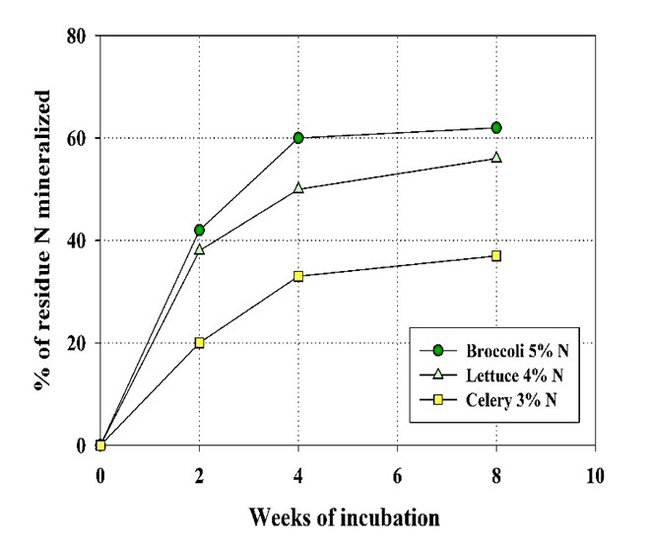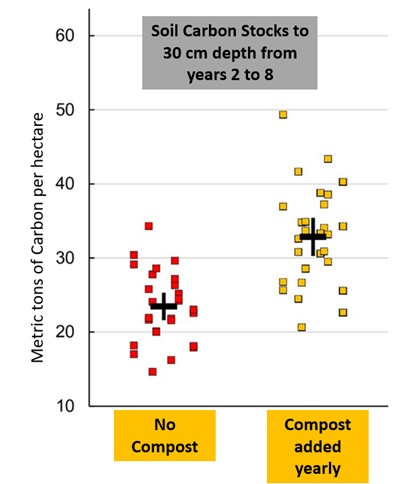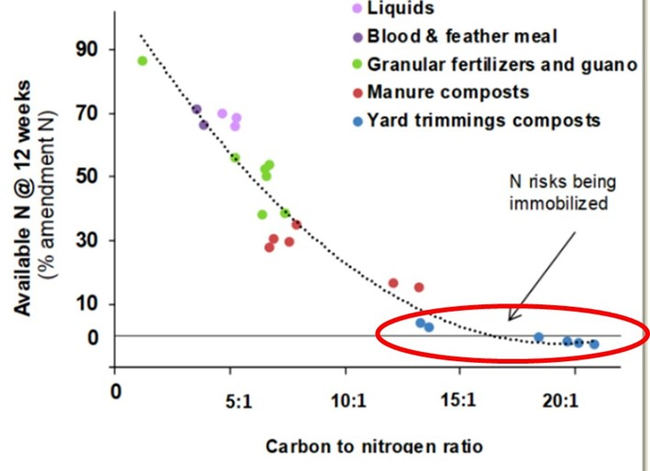Richard Smith, Emeritus Vegetable Crop and Weed Science Farm Advisor; Eric Brennan, Research Horticulturalist USDA, ARS; Daniel Geisseler, Plant Nutrition Specialist, UCD; and Joji Muramoto, Organic Farming Specialist, UCSC
In a recent blog on soil health, we discussed the importance of adding carbon to soils in Salinas Valley vegetable production operations to improve soil health. We grappled with the question, can additions of carbon to the soil help reduce the incidence and severity of soilborne diseases? At this point, there is not a straightforward answer to that question, but the issue of soil health as one of a series of approaches to managing soilborne disease cannot be entirely discounted. The reason is, that by increasing soil microbial activity, soilborne pathogens may be placed at a disadvantage due to predation from or competition with beneficial soil microbes. However, good scientific evidence of that specific effect is not yet well developed for key soilborne diseases such as Fusarium and Pythium wilts of lettuce.
Whether or not improving soil health reduces soilborne diseases, it does provide other critical benefits to soils (improved tilth, water infiltration and retention, etc) which provides incentives to employ practices that keep soils healthy and thereby improve the productivity of vegetables farms. Two of the three measures of soil health suggested by the Soil Health Institute are tied directly to soil carbon: 1) total soil carbon content of soil and 2) potentially mineralizable carbon content of soil. Increasing the quantity of carbon to the soil and/or retaining carbon in the soil (by minimizing tillage), are key practices that move a soil towards improved soil health.
As will be seen in our discussion below, some sources of carbon are more long-lasting than others. The C:N ratio drives the rate of decomposition of the material. All organic materials have a rapid phase of decomposition in which the labile (i.e., easily decomposable) materials are quickly broken down in 4-6 weeks. This phase is followed by a slower, steady rate of decomposition in which the recalcitrant (i.e., decomposition resistant) materials break down over an extended period of time that is measured in months/years.
The following is a brief discussion of the sources of carbon for soils in Salinas Valley vegetable production operations.
Cash Crop Residues and Root Exudates: Cash crops provide carbon to the soil when crop residues are incorporated after harvest and through root exudates while the crop is growing. Table 1 shows that cole crops such as broccoli and Brussels sprouts return the highest amount of residue and carbon to the soil of the commonly grown vegetables. They are followed by celery, lettuce and then spinach. This biomass and carbon data are average values from measurements of crops in commercial production fields. There is significant variability in the data due to differences from field to field, but these average values provide a reasonable estimate of the amount of carbon returned to the soil when crops are terminated. The high concentration of nitrogen in vegetable crop tissue drives rapid decomposition of a large portion of the residual biomass in the first four to six weeks after incorporation. The higher the percent nitrogen in the tissue, the higher the initial rate of mineralization of the residue (Figure 1). However, after the initial phase of decomposition of the labile carbon fraction, the rate of decomposition significantly declines which provides a longer-term source of carbon to the soil. The main vegetable rotations in the Salinas Valley, such as lettuce and broccoli, provide moderate to high amounts of carbon to the soil. Although a significant amount of carbon is mineralized due to the high nitrogen content of the residue, a significant amount of long-term carbon remains in the soil. In addition to crop residues, crop plants add considerable amounts of carbon to the soil in root biomass and as exudates. For example, the long-term, organic systems study at the USDA-ARS in Salinas found that over 8 years with 8 crops of lettuce and 6 crops of broccoli, roughly a third of the carbon inputs from the vegetables came from root biomass and root exudates, with more than half of the below ground inputs coming from root exudates (White et al. 2020). Root exudates are being researched for their role in stimulating soil microbes and suppressing soilborne pathogens. This is clearly an important area of research that needs more attention.
Table 1. Sources of carbon for Salinas Valley soils
1 – estimate; 2 – at 10 lbs per gallon; 3 – example from Dong et al, 2019. 4. Cover crop data, other than for white mustard, is based on Brennan and Boyd 2012, and Brennan et al. 2013.
Figure 1. Mineralization of vegetable crop residues with different concentrations of N in the tissue. Source: Hartz 2020.
Cover Crop Residues and Root Exudates: Biomass and carbon inputs to the soil from cover crops also vary widely depending on the planting date, variety, growing conditions, etc. Biomass and carbon additions by cover crops was similar to the higher producing vegetable crops. However, the percent nitrogen and resulting C:N ratio of the residue varies depending on when the crop is terminated and incorporated into the soil. Cover crops that are allowed to mature have lower nitrogen and greater carbon contents, as well as contain more biomass (Table 2). To obtain the greatest quantity of carbon from the cover crop, it is best to allow cover crops to mature as long as possible given all the practical constraints such as: availability of equipment, weather conditions, scheduled planting the subsequent cash crop and the risk of seed set by the cover crop. For more information about the risk of seed set by cover crops see: https://ucanr.edu/blogs/blogcore/postdetail.cfm?postnum=55520. Unfortunately, due to the issues with high land rents and crop production scheduling issues, cover crops are used on only about 5% of vegetable production ground. The nitrogen scavenging credits for over-wintered cover crops in Ag Order 4.0 will hopefully increase their use; this video discusses these credits. Also, creative use of cover crops such as fall-grown cover crops (Aug-Sept to Oct-Nov) may also increase the use of cover crops.
The on-going, long-term organic cropping systems study at the USDA-ARS in Salinas estimated that carbon addition from cover crop roots were about 18% of the carbon added by the cover crop shoots, and that carbon from cover crop root exudates was slightly more than half (about 64%) of the carbon in cover crop root biomass. So if we assume that shoot and root biomass is about 42% carbon, a cover crop that produces 4500 lbs/acre of oven dry shoot biomass (the minimum required in the Ag. Order 4.0 regulation) would add approximately the following amounts of carbon to the soil from shoot biomass (1890 lbs carbon/acre), root biomass (340 lbs carbon/acre), and root exudates (218 lbs carbon/acre), or 2448 lbs carbon/acre overall. These estimates are based on data from this this recent paper (White at al. 2020). When carbon is added to the soil as crop residue, it is essentially adding energy to the soil that helps to fuel the biomass and the diversity of organisms in the soil food web. You can estimate the amount of oven-dry shoot biomass that a cereal cover crop adds to the soil by measuring the length of main stem as described in this video (A Simple Method to Help Farmers Estimate Cereal Cover Crop Shoot Biomass).
Table 2. Cover crop biomass and carbon accumulation over 3 weeks
Compost and manure: The use of manure and compost in vegetable production has declined in recent years due to food safety concerns. However, the use of compost is one of easiest and most cost-effective ways to increase the quantity of carbon in soils. In the long-term organic systems study at the USDA-ARS in Salinas the yearly application of compost increased total soil carbon (Figure 2).
Many produce buyers restrict the use of compost due to food safety concerns, but ironically, many of these same buyers encourage growers to employ sustainable production practices. Clearly, there is a disconnect between these two influences exerted by the buyers. Recently, both large individual processors and the Leafy Greens Marketing Agreement have focused attention on substantially improving confidence in the safety of compost. A systems-based approach between the leafy greens growers/handlers and a few engaged composters, distributors, and hauler/spreaders have been conducted to identify key knowledge gaps, assess the need for new validation studies, and to establish an enhanced verification system of process control requirements. Given the importance of adding carbon into Salinas Valley soils, it is important to encourage the use of compost if food safety concerns can be effectively managed.
Figure 2. Data shows levels of soil carbon in soil in treatment plots with yearly compost application versus no compost addition. Cover crops were grown every 4 years and both treatments received the same inputs of organic fertilizers. Crosses show the average of all data points within each treatment . Source: Figure 6 in White et al. 2020.
Organic Fertilizers: As shown in Table 1, organic fertilizers contain substantial amounts of carbon. The amount of carbon applied in typical application scenarios used by growers indicates that high amounts of carbon are also added with the nitrogen and other nutrients that they contain. The C:N ratio of dry organic fertilizers is generally low and from 40 to 60% of material decomposes in the first twelve weeks after application (Figure 3). However, a significant amount of the carbon in these materials is recalcitrant and remains in the soil as a long-term source (Hartz et al, 2000). In a recent study comparing 20 paired organic vs conventional farms where the main difference in carbon inputs was organic fertilizer, found higher microbial biomass in the soil of the organic farms (Smith et al, 2022).
The percent carbon in liquid organic fertilizers can vary from 15 to 25% (Table 1). For instance, if a material weighs 10 lbs/gallon that would be equivalent to 1.5 to 2.5 lbs carbon per gallon of material. Little is known about the mineralization characteristics of carbon in liquid fertilizers, but it makes sense that it may be fairly labile, if for no other reason, because the particle size of the material is small and readily accessible to microbes.
Figure 3. Percent mineralization of nitrogen from yard waste compost and organic fertilizers in 12 weeks (the nitrogen data is used as a proxy for the proportion of mineralization of carbon from these materials).Source: Lazicki et al, 2020.
Humic Acid Materials: We recently evaluated dry and liquid humic acid materials. The dry humic material contained 38% carbon and the liquid material contained 3.5% (if the material weighs 10 lbs/gallon = 0.35 lbs carbon/gallon). Clearly, these materials are a modest source of carbon, given the amount of these materials typically added to the soil.
Biochar: Is a charcoal-like source of carbon that can be made from a variety of sources of biomass at high temperatures in an oxygen limited environment (pyrolysis). The resulting material has properties that are different than biomass that has broken down as the result of microbial decomposition. Depending on the feedstocks and temperatures used, the material can vary in surface area, porosity, ash content and C:N ratio. One study measured that the carbon content of biochar was about 50% (Dong et al. 2019). There is a great deal of research being conducted on biochar to better understand the benefits that it provides depending on its specific characteristics. Sanjai Parikh at UCD gave a nice summary of biochar in this presentation: https://www.cdfa.ca.gov/is/ffldrs/frep/pdfs/Biochar/ParikhFREPBiocharPresentation.pdf
For the purposes of this article, we will not delve deeply into this material, but suffice to say that it provides a unique source of carbon that does not necessarily feed the microbial community, but does play other roles in the soil.
In summary: Additions of carbon to the soil provide a key practice for improving soil health. Crop residues provide the most constant and consistent source of carbon for Salinas Valley soils. However, growers can augment carbon additions to soils by growing cover crops and applying compost. Organic growers benefit from the use of organic fertilizers which also contain significant quantities of carbon. Compost is a concentrated source of organic matter that was shown to have long-lasting effects by increasing levels of carbon in the soil.
References:
Brennan E.B., N.S. Boyd. 2012. Winter cover crop seeding rate and variety affects during eight years of organic vegetables: I. Cover crop biomass production. Agronomy Journal 104:684-698.
Brennan E.B., N.S. Boyd, R.F. Smith. 2013. Winter cover crop seeding rate and variety affects during eight years of organic vegetables: III. Cover crop residue quality and nitrogen mineralization. Agronomy Journal 105171-182.
Dong, X., B. Singh, G. Li, Q. Lin, X. Zhao. 2019. Biochar increased field soil inorganic carbon content five years after application. Soil and Tillage Research 186; 36-41.
Hartz, T.K., Mitchell, J.P., Giannini, C., 2000. Nitrogen and carbon mineralization dynamics of manures and composts. Hortscience 35, 209-212.
Hartz T.K., T.G. Bottoms. 2010. Humic Substances Generally Ineffective in Improving Vegetable Crop Nutrient Uptake or Productivity. Hortscience 45:906-910.v
Hartz, T.K. 2020. Efficient Nutrient Management in California Vegetable Production, UC Agriculture and Natural Resources Publishing, Publication 3555. pp. 122.
Lazicki, P., Geisseler, D., Lloyd, M., 2020. Nitrogen mineralization from organic amendments is variable but predictable. Journal of Environmental Quality, DOI: 10.1002/jeq1002.20030, available at https://acsess.onlinelibrary.wiley.com/doi/full/10.1002/jeq2.20030
Smith, R.F., M. Cahn, T. Hartz, D. Geisseler and P. Love. 2022. Nitrogen and phosphorus management of organic cool-season leafy green vegetables on large-scale farms on the Central Coast. California Agriculture 72(2):77-84.
https://calag.ucanr.edu/archive/?type=pdf&article=ca.2022a0010
White K.E., E.B. Brennan, M.A. Cavigelli, R.F. Smith. 2020. Winter cover crops increase readily decomposable soil carbon, but compost drives total soil carbon during eight years of intensive, organic vegetable production in California. PLoS One 15:e0228677.



